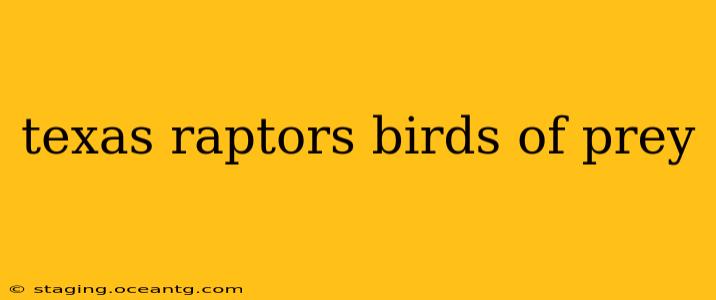Texas, with its diverse landscapes ranging from arid deserts to lush forests, provides a rich habitat for a variety of magnificent birds of prey. These raptors, masters of the sky, play a crucial role in the state's ecosystem. From the ubiquitous Red-tailed Hawk to the more elusive Ferruginous Hawk, understanding these incredible birds is key to appreciating Texas's biodiversity. This guide explores the fascinating world of Texas raptors, answering common questions and delving into the details of these aerial predators.
What types of raptors live in Texas?
Texas boasts a surprisingly diverse array of raptor species. Some of the most commonly sighted include:
- Red-tailed Hawk: This is arguably the most widespread and recognizable raptor in Texas. Their characteristic red tail (though sometimes absent in immature birds) and soaring flight patterns make them easy to identify.
- Cooper's Hawk: A slightly smaller, more agile hawk, often found in wooded areas, pursuing smaller birds. They are known for their speed and precision in hunting.
- Sharp-shinned Hawk: The smallest of the accipiters (a group of hawks known for their agility), these birds are incredibly swift and efficient hunters of small birds.
- Northern Goshawk: Larger than the Cooper's and Sharp-shinned Hawks, the Northern Goshawk is a powerful predator of forest birds and even small mammals. They are less common than other hawks in Texas.
- Ferruginous Hawk: A large, striking hawk of the western plains, characterized by its reddish-brown plumage. While less common in the eastern parts of Texas, they can still be spotted in suitable habitats.
- American Kestrel: The smallest falcon in North America, this colourful bird is often seen perched on utility poles or fence posts, scanning for insects and small rodents.
- Peregrine Falcon: The fastest animal on Earth, the Peregrine Falcon is a powerful predator known for its spectacular aerial acrobatics during hunts. They are found throughout Texas, although not in high numbers.
- Bald Eagle: While not as common as some other raptors, the Bald Eagle's population has steadily grown in Texas in recent decades. They are majestic birds often seen near large bodies of water.
- Great Horned Owl: Although not a diurnal (day-active) bird, the Great Horned Owl is a significant predator in Texas. Their nocturnal hunting habits make sightings less frequent.
What is the largest raptor in Texas?
The Bald Eagle and the Ferruginous Hawk compete for the title of largest raptor in Texas. While the Bald Eagle can have a larger wingspan, the Ferruginous Hawk is often heavier and more robust. Their size can vary depending on individual birds and their sex.
Where can I see raptors in Texas?
Raptors can be found throughout Texas, but their distribution depends on the species and its habitat preference. Excellent locations for raptor viewing include:
- State Parks: Many Texas state parks offer opportunities to observe raptors in their natural habitats. Look for parks with diverse ecosystems, including forests, grasslands, and wetlands.
- Wildlife Refuges: National wildlife refuges provide protected areas where raptors thrive. These areas often have viewing platforms and educational resources.
- Open Fields and Prairies: These habitats provide hunting grounds for many raptor species. Look for birds perched on fence posts or soaring overhead.
- Along Rivers and Coastlines: Bald Eagles and other fish-eating birds are frequently found near rivers, lakes, and coastal areas.
How can I help protect Texas raptors?
Protecting Texas raptors requires a multifaceted approach:
- Habitat Conservation: Protecting and restoring natural habitats is crucial for raptor survival. This includes protecting forests, grasslands, and wetlands from development and degradation.
- Reducing Pesticide Use: Pesticides can harm raptors directly and indirectly through the food chain. Using environmentally friendly alternatives is essential.
- Supporting Conservation Organizations: Many organizations work to protect raptors and their habitats. Supporting these groups through donations or volunteering can make a significant difference.
- Responsible Recreation: Avoid disturbing nesting sites and keep a safe distance when observing raptors in the wild.
What are the threats to Texas raptors?
Several threats endanger Texas raptors:
- Habitat Loss: The conversion of natural habitats to agricultural land and urban development is a significant threat.
- Pesticide Poisoning: Exposure to pesticides can weaken raptors and reduce their reproductive success.
- Collisions with Power Lines and Wind Turbines: These structures pose a significant risk to flying birds.
- Illegal Shooting and Trapping: While illegal, these activities still pose a threat to raptor populations.
By understanding the challenges facing Texas raptors and supporting conservation efforts, we can help ensure these magnificent birds continue to soar across the Lone Star State for generations to come. Their presence enriches our environment and offers a captivating glimpse into the wild beauty of Texas.
